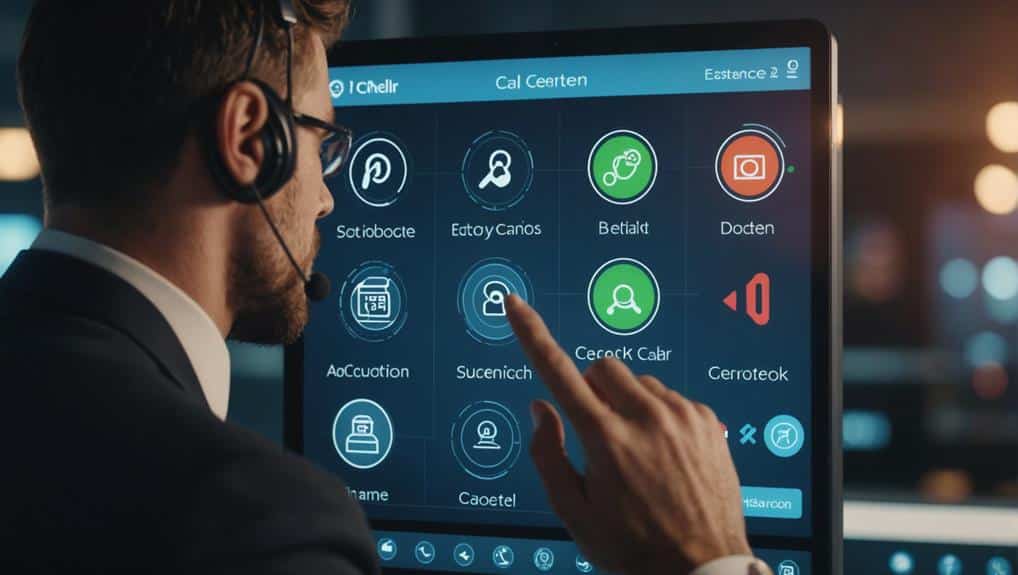When you are busy and miss calls, you risk losing business opportunities. Small or large, these missed calls can quickly add up, affecting customer loyalty and your bottom line. But don’t worry! There are practical strategies for fixing this problem using modern communication tools and innovative management techniques.
If you are often busy and missing calls, you need to take action to stop losing money. This blog will explore seven solutions that help you handle overlooked calls efficiently and prevent customer loss. These strategies will guide you toward a more resilient way to interact with your customers. Stay with us as we reveal how you can improve customer service and grow your business.
Key Takeaways
- Implement efficient call-waiting features like call queuing and night mode to manage high call volumes and prevent missed calls.
- Customize call systems with features like IVR menus, voicemail-to-email functionality, and data-driven optimization for effective call handling.
- Integrate modern communication tools such as CRM databases and automated replies to enhance efficiency and decrease missed call rates.
- Through call logging and continuous monitoring, utilize call data to improve service, refine processes, and identify areas for improvement.
Understanding the Impact of Missed Calls
Often overlooked, missed calls significantly impact potential revenue loss, damage client relationships, and hinder business growth. These interruptions in communication create fissures in the customer journey, fostering customer dissatisfaction. When a client’s call goes unanswered, it signifies a missed opportunity to engage and risks the erosion of trust and loyalty, essential components of customer retention.
These missed opportunities can significantly affect company performance. Beyond the immediate revenue loss, they can also limit the business’s expansion potential. A more insidious effect is the long-term impact on company perception. Missed calls can project an image of indifference or incompetence, which can be difficult to rectify in customers’ minds.
In a competitive business landscape, addressing missed calls becomes vital to preventing customer attrition and reputation damage. A missed call is not just a missed conversation; it’s a missed opportunity to impress, to solve a problem, or to make a sale. It’s time businesses fully comprehend the gravity of this often overlooked issue and take necessary action to mitigate the consequences.
Identifying the Reasons Behind Unanswered Calls

Understanding the reasons behind unanswered calls is the first step in devising strategies to handle them effectively. Potential causes include staffing and resource limitations, technological system failures, and clients’ preferred communication channels. By identifying these factors, we can address the root causes of missed calls and improve overall client service.
Staffing and Resource Limitations
With high hiring costs and restricted personnel resources, businesses may grapple with numerous unanswered calls. Staffing and resource limitations can significantly impact customer experience, potentially leading to customer dissatisfaction and loss.
Businesses must acknowledge that missed calls equate to missed opportunities. By not answering customer calls, enterprises risk losing a potential sale and damaging the customer’s perception of the brand. Therefore, addressing these staffing and resource limitations is crucial in maintaining customer satisfaction and loyalty.
| Reason for Unanswered Calls | Possible Solution |
|---|---|
| High hiring costs | Consider outsourcing or virtual assistance |
| Limited personnel resources | Implement shift scheduling |
| Prioritization of digital communication over calls | Balance between digital and phone communication |
| No 24/7 customer service | Explore options for after-hours service |
| Ignoring customer preference for phone communication | Regularly assess customer communication preferences |
Speedy AI Solutions for Handling Missed Calls
Missed calls can be frustrating and lead to lost opportunities, especially when you have paid for ads or purchased leads. An easy and cost-effective solution involves using AI to handle these missed calls efficiently. When a call goes unanswered, AI can quickly reroute the call to another available line or send an automatic text message to the caller, letting them know that their call is important and will be addressed soon.
AI technology can also notify the business owner immediately about the missed call, ensuring they know the situation. This real-time alert lets the owner prioritize returning the call, showing customers their time and business are valued. Speed is essential in maintaining customer satisfaction and reducing frustration, so immediate communication is crucial.
By informing callers that they are in the queue and will be attended to shortly, AI helps manage customer expectations and keeps them engaged. This swift response reduces the chances of losing a potential customer and enhances the overall customer experience. Implementing AI solutions ensures businesses can handle calls effectively, even during busy periods.
Technological System Failures
Technological system failures represent another substantial factor contributing to unanswered calls, often negatively impacting both client satisfaction and the potential for business growth. These failures can arise from various causes, such as system glitches, network issues, and outdated equipment, which impede call handling efficiency.
Understanding the root cause of these technological breakdowns is crucial. This knowledge enables businesses to implement practical solutions that significantly reduce missed calls. Regular system maintenance, timely software updates, and diligent monitoring of call system performance are all sensible measures to help guarantee a more reliable and efficient call-handling process.
Investment in modern communication technology should not be underestimated. Features of technologies such as Voice over Internet Protocol (VoIP) and Customer Relationship Management (CRM) integration enhance call handling capabilities and minimize technological system failures. By taking these steps, businesses can notably improve their responsiveness to customer calls, thereby increasing customer satisfaction and fostering a sense of belonging among their client base.
Preferred Communication Channels
To effectively combat the issue of unanswered calls, it is essential to analyze customer’s preferred communication channels. These channels are greatly influenced by customer preferences, shaped by age demographics, digital fluency, and industry norms. By closely analyzing call data, businesses can identify trends in these preferred communication methods and devise strategies to reduce unanswered calls.
Insights gained from customer feedback and market research can significantly aid this process. These feedback mechanisms can reveal what communication channels customers feel more comfortable with and which they are more likely to engage with.
Offering multiple communication channels is also a proven strategy to cater to different customer preferences. It ensures that customers have the freedom to choose their preferred method of communication, thereby increasing the chances of effective communication and reducing missed calls.
| Preferred Communication Channel | Reason |
|---|---|
| Phone Calls | Immediate response |
| Detailed and can be referenced later | |
| Social Media | Convenience and familiarity |
| Live Chat | Instant responses without verbal communication |
| SMS | Quick and concise information |
Implementing Efficient Call Waiting Features

Efficient call waiting characteristics can significantly improve customer experience by managing their expectations and reducing the number of missed calls. Introducing such systems, with features like call queuing and night mode, could transform a business’s communication efficiency. This section will explore these characteristics, their advantages, and how they could be effectively implemented to guarantee a fair and satisfactory interaction for every caller.
Call Queuing Advantages
Recognizing its significant role in preventing missed opportunities, call queuing offers many advantages, especially its ability to enhance customer satisfaction by minimizing wait times and ensuring every call is answered promptly and efficiently. Placing callers in a structured queue mitigates the risk of customers dropping off due to extended hold times.
Many businesses face high call volumes, making call queuing a practical solution that ensures all calls are managed effectively. Companies can maintain smooth customer service by systematically distributing calls among available agents, even during peak times.
Furthermore, call queuing can create a more engaging waiting experience. It can be personalized to play music or promotional messages, keeping callers informed and entertained. This helps reduce perceived wait time and provides an opportunity to promote products or services.
Call queuing is essential for any business that values customer satisfaction and aims never to miss an opportunity. It helps manage high call volumes and contributes to a positive customer experience, promoting a sense of belonging and value among callers.
Night Mode Functionality
Building upon the importance of managing high call volumes during office hours, the concept of night mode functionality takes this step further by guaranteeing calls are handled effectively outside regular business hours. This solution is pivotal for businesses aiming to curb the tide of missed opportunities resulting from calls that come in after operating hours.
Night mode functionality is more than an ‘out of office’ automated response. It allows calls to be redirected to alternative numbers, guaranteeing that each caller is attended to promptly. This feature can be tailored to play specific messages, informing callers about business hours and reassuring them that their concerns are significant. This level of detailed personalization fosters a sense of belonging among clients, enhancing their overall experience.
Implementing efficient call-waiting features during night mode can significantly impact customer satisfaction and retention. Each call handled professionally and empathetically, even outside regular business hours, is a step towards preventing missed sales and enhancing revenue generation. Hence, night mode functionality is a feature and a strategic tool for business growth. By leveraging this, businesses can ensure they are always open to opportunities, regardless of the time of day.
Utilizing Call Data for Improved Service

Harnessing the power of call data offers numerous opportunities for enhancing service efficacy, ranging from better staff allocation and process refinement to cost-effective call-handling solutions. By analyzing customer data and call statistics, businesses can identify areas of improvement and implement strategies that cater to their clients’ distinct needs and expectations.
Integrating call data with CRM databases allows for tailored responses and swift caller identification, creating a more personal and gratifying customer experience. Call logging has become invaluable, tracking incoming and outgoing calls for detailed analysis and adjusting call plans.
Wallboards are another essential tool, displaying up-to-the-minute call statistics for continuous monitoring and performance evaluation. Such transparency fosters an environment of responsibility and ongoing enhancement.
Customizing Call Systems for Optimal Use

To optimize call handling efficiency, it is crucial to customize call systems with beneficial features such as call queuing, Interactive Voice Response (IVR) menus, and hunt groups. Call queuing can manage high call volumes, reduce the risk of missed calls, and enhance the caller experience. On the other hand, IVR menus guide callers through a series of options, connecting them to the most appropriate department or representative, thereby saving time and resources.
Additionally, integrating CRM databases with call systems allows for quicker caller identification, fostering tailored interactions. Recognizing customers promptly and attending to their needs can significantly improve customer satisfaction and loyalty.
Voicemail-to-email functionality is another feature that can streamline your message management efforts. This guarantees that no crucial message goes unnoticed and that responses to missed calls are timely.
Lastly, call logging and wallboards can provide valuable insights and up-to-the-minute statistics for monitoring and optimization purposes. This data-driven approach can help identify bottlenecks in your system, enabling you to make necessary adjustments for enhanced efficiency and customer retention.
Integrating Modern Communication Tools

As we continue to explore call management, it’s worth mentioning how integrating modern communication tools can significantly enhance efficiency and customer retention. CRM integration, for instance, can improve customer retention by offering tailored customer experiences. Combining your CRM system with communication tools lets you comprehensively view customer interactions and personalize your communications to meet specific needs.
Automated replies and scheduling options are other contemporary tools that can effectively decrease the number of missed calls. These enable businesses to promptly respond to customer inquiries outside regular operating hours, ensuring no customer feels excluded or disregarded. Using these tools can result in a decrease in missed call rates by up to 20%.
Another notable feature is the voicemail-to-text option. By incorporating this in your communication toolkit, you can lessen the impact of missed calls on your revenue by as much as 10%. This feature guarantees you never overlook an important message and allows for a faster response time.
Evaluating and Optimizing Call Handling Systems

In the pursuit of excellent client service, the evaluation and optimization of call handling systems emerge as an essential aspect, involving an in-depth analysis of call data, strict monitoring of call statistics, and unearthing areas needing improvement. This process is not simply about identifying problem points but about guaranteeing that each interaction adds value to the customer journey, amplifying customer satisfaction and boosting revenue.
An effective way to enhance call handling systems is through integrating CRM systems. This integration enhances caller identification and tailors responses, fostering a sense of belonging among customers. Furthermore, customer feedback is invaluable in this process, highlighting areas that need fine-tuning.
In addition, call queuing, IVR menus, and hunt groups can streamline call processes. Tools like voicemail-to-email, night mode, and SIP trunks can further strengthen the system’s efficiency and effectiveness. By focusing on these measures, businesses can guarantee that no call, and thus no customer, is inadvertently overlooked, turning potential losses into wins.
Frequently Asked Questions
How Do You Handle Being Busy and Missing Calls?
Effective call handling involves implementing strategies like call queuing, utilizing interactive voice response (IVR) systems, setting up hunt groups, employing night mode, and enabling voicemail-to-email features for efficient message retrieval and management.
How Do You Keep Control of Customer Service Calls?
Control of client service calls is maintained by implementing efficient call handling systems like call queuing, call menus, hunt groups, night mode, and voicemail to email. This guarantees prompt and effective responses to client inquiries.
How Do You Handle Difficult Customer Service Calls?
Handling challenging customer service calls involves active listening, empathetic responses, and positive language. Offering solutions, taking ownership of issues, and ensuring prompt follow-ups are essential. Continuous training enhances customer service representatives’ handling of demanding calls.
How Would You Handle a Customer Service Call?
When handling a client service call, listening attentively, responding empathetically, and resolving the issue efficiently are vital. Offering a callback option can help manage high call volumes and guarantee client needs are met.
Conclusion
To sum up, being busy and missing calls can harm your business. Missed calls increase customer frustration and result in missed opportunities. This is especially troublesome if you paid for ads or purchased leads only to miss those key callers. Speed is the key to client communication; ensuring every call is answered promptly is vital.
Modern technology offers cost-effective solutions to handle phone calls efficiently. Using virtual receptionists, AI-driven solutions, and advanced call screening technologies can help manage incoming calls, even during peak times. These options provide a personal touch while addressing customer inquiries and scheduling appointments. This keeps potential customers engaged and reduces the chance of poor customer service.
Missed calls mean lost sales and unhappy customers. Invest in tools that provide quick responses and seamless integration with your communication systems to maintain strong customer relationships and ensure business success. Doing so can improve customer satisfaction, boost customer loyalty, and create a more reliable business communication strategy. Keep your customers happy, prevent bad experiences, and avoid the actual cost of unanswered calls.


Recent Comments